Fruit - Food of the Gods
Español  Ukrainian
Ukrainian 
What is a Fruit?
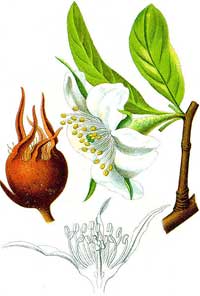 Many plants produce fruits in order to help in the dispersal of their seeds. It would be pointless for a plant to drop all its seeds directly beneath, by its roots, since all the seedlings would then compete with each other and their parent. Plants have therefore evolved various mechanisms by which their seeds can be dispersed. Some plants, such as sycamore, have dry spiky or leathery fruits which may be dispersed by the wind, others such as burdock have barbs that attach themselves to animals' fur or our clothing, but the fruits that we are interested in here are those fleshy fruits which the plant has made attractive for animals to eat.
Many plants produce fruits in order to help in the dispersal of their seeds. It would be pointless for a plant to drop all its seeds directly beneath, by its roots, since all the seedlings would then compete with each other and their parent. Plants have therefore evolved various mechanisms by which their seeds can be dispersed. Some plants, such as sycamore, have dry spiky or leathery fruits which may be dispersed by the wind, others such as burdock have barbs that attach themselves to animals' fur or our clothing, but the fruits that we are interested in here are those fleshy fruits which the plant has made attractive for animals to eat.
As the seeds mature, the ovary and sometimes also the receptacle swell up around the seeds to become a juicy, fleshy and often sweet fruit. The seeds inside usually have a tough outer coat so that when the animal eats the fruit it will either, if the seeds are small, deposit the seeds unharmed in its faeces some distance from the parent plant e.g. the pips in soft fruit, or if the seed is large, as in plums, the fruit may be carried away and the seed dropped somewhere. Normally the fruit tastes awful before the seeds are ripe, so it will not get eaten before the seeds are mature enough to germinate. Seeds and fruit therefore ripen at the same time to ensure that the seeds are at the right stage when taken by an animal. Either way the animal has “paid” for its nice meal by doing the plant a favour in dispersing it seeds.
One of the wonderful things about fruits is that we are actually eating something offered to us by the plant. Assuming that we are living a fairly natural lifestyle -i.e. not eating imported fruit that could never grow in this climate, eating fresh fruit that is in season, not eating seedless varieties, not throwing fruit seeds or cores into the rubbish bin where they have no chance of re-entering the natural cycle - then you could say that the plant would want us to eat the fruit. In turn the plant has done us a favour by producing this nice juicy, tasty morsel full of naturally filtered water, natural sugars, flavours, vitamins and minerals and other nutrients. Fruits are amongst the most delicious foods on Earth. Most are light and easy to digest and they are a natural convenience food because there is normally no preparation needed.
The Nutritional Value of Fruits
Most fruits are very easy to digest because food is stored in the fruit as sugars. (Unripe fruits are often high in starch and organic acids, which makes them taste very sour, and these are converted to sugars only as the fruit ripens). Most fruits contain no fats at all though some, such as olives and avocados have quite a high fat content. Whilst it is not really feasible to grow these fruits in temperate areas, we can grow Elaeagnus and Hippophae berries which contain Essential Fatty Acids (EFA’s).
Most fruits also contain no protein. Protein and fats are present in the seed but this is usually not eaten (e.g. in plums) or passes straight through (pips in berries) so fruits are NOT a complete food and could not really be recommended as the sole part of the diet. Also, unless you eat Special Berries (see below) all year round, you will go quite short of minerals. Most fruits are particularly low in calcium and magnesium which are necessary for healthy teeth and bones.
Fruits are also very low in zinc which is essential for the function of the immune system, the formation of skin, the healing of wounds, brain function and it is essential for the function of the reproductive organs. But do not despair, this deficiency can be made up by eating plenty of green leaves (see the section ‘Green Gold’ ).
Fruits are best eaten fresh, ripe and raw. There is normally no need to cook them - unless you have a glut and want to preserve some by bottling it (which can be done without sugar if your jar has a good seal), or if there are windfall apples that are not ripe enough to eat raw. But it is preferable if cooked fruit only forms a small part of the diet, as it is so much healthier and more satisfying to eat them raw.
A word of warning about fruits for those who are not use to eating much of it: Like leaves, fruits are a very strongly cleansing food, capable of stirring up and removing toxins that were long buried in the body. (These toxins come from certain foods, especially “junk food” with chemical additives, an excess of meat, dairy products etc. and environmental toxins). However unlike leaves, which actually help to carry toxins out of the body as well, fruits often tend to stir them up without carrying them away. So if you know that your diet has not been all it could have been over the last few years and that your system is liable to be rather toxic, then please approach fruit with caution.
Do not suddenly eat a lot of fruit in one go (especially of the more acid berries) until you know that your system can cope with it. What is liable to happen is that a lot of toxins will be stirred up into what is known as a Healing Crisis and you will feel ill. Perhaps you will blame the healthy diet for making you ill and perhaps even go to the doctor for some pills. These will only suppress the symptoms and drive the toxins deeper into the body, as well as adding more toxins, -so you will be worse off than before. So unless you understand about healing crises and know how to manage them, please go easy on the fruit if you are not used to it. Many Naturopaths have used short-term fruit diets for healing with a great deal of success. This is because of the wonderful cleansing and healing properties of fruits, especially if accompanied by green leaves or leaf juices. However this tends to be too drastic for most people nowadays because of the general decrease in health and nutrition of the overall population. This is still possible to do but we would only recommend it under the guidance of a qualified Naturopath or Nutritional Therapist.
The types of fruit
Fruits contain quite good levels of vitamins but are quite low in many important minerals. On their own, they will not provide you with enough minerals. Indeed, if you just ate fruit and nothing else for a while, you might lose all your teeth. So perhaps it would be all right to eat a lot of fruit as long as one eats a lot of leaves as well? If you study the tables of mineral composition of various different fruits, three main groups emerge.
- 1). The large cultivated fruits such as apples, pears and tomatoes.
.jpg)

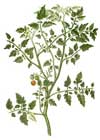
- Although these form the bulk of most people’s fruit intake, they are pretty low in minerals and vitamins. They have been selectively bred, sometimes over thousands of years, in order to produce a bigger size, milder flavour, more sugar and higher water content. Unfortunately the nutrient content has sadly lost out. Hence the wild crab apples and pears - though often inedible due to their acidity and astringency - are actually more nutritious than the cultivated ones. A clear example of this can be seen if we look at the tomato. The wild tomato is no larger than a cherry, yet a single fruit contains more vitamins and minerals than a single much larger cultivated tomato. When comparing the size of each fruit you begin to realise just how much nutrient we have lost from many of our cultivated foods!
- 2). Small berries such as strawberries, raspberries, blackberries, blackcurrants and gooseberries.

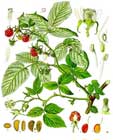



- These are far richer in minerals than the first group. Although these berries have also been bred up for size etc., they are much closer to their natural state than the big fruits, and consequently are richer in nutrients. However, they still do not compare in nutritional value to green leaves vThe berries are also higher in fibre (the pips really do help to
keep you regular!) and lower in calories. - 3). The special berries.
- These are normally wild plants that have not been bred up and hence not been devitalised and demineralised in that way. They are much richer in nutrients than the other fruits and also often have great medicinal value. A few examples are mentioned below: -.
.jpg)
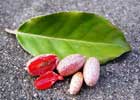 Hippophae and Elaeagnus These, and especially the Hippophae, are the special fruits par excellence. They are probably the most nutritious fruits you can grow in the Temperate zone and are a very rich source of vitamins and minerals. In particular they are very good sources of vitamin C and bioflavinoids, as well as containing essential fatty acids (EFA’s). (See the leaflets on Hippophae salicifolia and Elaeagnus x ebbingei for more details.)
Hippophae and Elaeagnus These, and especially the Hippophae, are the special fruits par excellence. They are probably the most nutritious fruits you can grow in the Temperate zone and are a very rich source of vitamins and minerals. In particular they are very good sources of vitamin C and bioflavinoids, as well as containing essential fatty acids (EFA’s). (See the leaflets on Hippophae salicifolia and Elaeagnus x ebbingei for more details.)
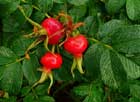 Rosehips. Whilst wild rosehips are extremely nutritious, most are small and fiddly to harvest and use because the layer of flesh covering the hairy seeds is very thin. However, Rosa rugosa has particularly large hips which can be eaten much more easily (and certain varieties have larger fruits than others). Another good source of vitamin C, it also contains some EFA’s and is also very high in carotene or provitamin A, the precursor of vitamin A. While true vitamin A or retinol, which is only found in animal products, is toxic in large amounts, carotene is found in plant foods and is totally non-toxic. The body only makes as much vitamin A from it as it needs. Ripe Rosa rugosa fruits are also extremely delicious - true ambrosia!
Rosehips. Whilst wild rosehips are extremely nutritious, most are small and fiddly to harvest and use because the layer of flesh covering the hairy seeds is very thin. However, Rosa rugosa has particularly large hips which can be eaten much more easily (and certain varieties have larger fruits than others). Another good source of vitamin C, it also contains some EFA’s and is also very high in carotene or provitamin A, the precursor of vitamin A. While true vitamin A or retinol, which is only found in animal products, is toxic in large amounts, carotene is found in plant foods and is totally non-toxic. The body only makes as much vitamin A from it as it needs. Ripe Rosa rugosa fruits are also extremely delicious - true ambrosia!.jpg) Hawthorns. Whilst the fruits of the British two native hawthorns are edible few people are going to want to eat many of them. However, there are several species with cherry-size fruits that are absolutely delicious to eat. Again these fruits are high in bioflavonoids and fairly high in vitamin C. They also have several useful medicinal properties including making a good heart tonic whilst reducing high blood pressure and cholesterol levels in the blood. See our leaflet on the hawthorns for more information.
Hawthorns. Whilst the fruits of the British two native hawthorns are edible few people are going to want to eat many of them. However, there are several species with cherry-size fruits that are absolutely delicious to eat. Again these fruits are high in bioflavonoids and fairly high in vitamin C. They also have several useful medicinal properties including making a good heart tonic whilst reducing high blood pressure and cholesterol levels in the blood. See our leaflet on the hawthorns for more information.
.jpg) Barberries (Berberis). These fruits usually have a rather acid flavour, but are pleasant nonetheless and go very well in muesli. They have a particularly beneficial effect on the urinary system, that they cleanse and stimulate.
Barberries (Berberis). These fruits usually have a rather acid flavour, but are pleasant nonetheless and go very well in muesli. They have a particularly beneficial effect on the urinary system, that they cleanse and stimulate.
It is particularly important that we take in vitamin C because so much of our food is cooked nowadays and thus largely devoid of vitamin C. Also, during evolution we lost the ability to manufacture Vitamin C in our own bodies so we are at a disadvantage to most other animals that can. This is one of the reasons why we need to eat lots of fresh raw food. Vitamin C is also useful in the treatment of many diseases ranging from colds to cancer.
Elaeagnus and Hippophae are very rich in bioflavonoids, which are beneficial plant pigments that assist in the utilisation of vitamin C and are said to improve the function of the brain. Bioflavonoids are also very beneficial to our health in many other ways. For example, the bioflavonoids found in the fruits of all Elaeagnus and Hippophae species have been shown to be an effective preventative for and treatment of cancer.
EFA’s are essential for the formation of healthy cell membranes and necessary for many body functions especially that of the immune system. Hence these fruits are extremely beneficial, but are of particular benefit for those with diseases of the immune system such as MS, ME, rheumatoid arthritis, juvenile onset diabetes, cancer and AIDS. This is especially true of the Hippophae. Considering also that high levels of vitamin C, B vitamins and minerals are also beneficial to the immune system, these berries are a particularly good food, tonic and medicine for anyone with an under functioning immune system.
So the general conclusion is that all fruit is good for you but some are more nutritious than others. They are not as nutritious as leaves, but they do taste better because the plant has deliberately laced the fruit with sugars and pleasant flavours to tempt us.
The fresh fruit season
It is important, as far as possible, to eat fruit that is fresh, ripe and in season. Fruits that are picked unripe will never
develop their full flavour, sweetness or nutritional value because the plant hasn’t had enough time to put all it wanted to in the fruit. Fruit that has been transported halfway across the globe is normally picked under ripe and sprayed to stop it rotting. It is also not in harmony with the climatic zone in which we live so is much less good for us, as well as contributing to unnecessary pollution in the transportation process. The ideal way to eat fruit is to eat it straight from the plant. Once it starts to age it loses its nutritional value in the same way as other parts of the plant do.
With careful planning it is possible to pick fresh fruit from your garden for 10 or even eleven months of the year. The season starts with the evergreen Elaeagnus in early April. These will continue to crop until the middle or end of May when Mahonias and the first strawberries ripen. The variety of fruits then increases considerably with the greatest abundance coming in late summer and early autumn. There are, however, many different fruits that can be harvested in late autumn and early winter. These include the Hippophae, which can be harvested until the middle of January, and various Gaultherias, which can be picked in early spring. However, these late harvests are usually quite small in quantity - more a nibble than a real meal.
Fruits that store
In order to extend the season, there are certain fruits that store very well with little loss of nutrient. Thus you can ensure a supply of fresh fruit throughout the winter, spring and early summer when few or no berries are available. A few of these fruits are detailed below:-
- The apple is the best example for this climate. There are many late-ripening varieties that will keep for varying amounts of time in storage, the latest storing for a whole year or more in good condition. These late keeping apples are normally not actually ready to be eaten when they are harvested. When in storage, the starches and acids in the fruit are gradually converted to sugars and the fruit becomes ripe over a period of weeks or months. If the late apples were allowed to ripen fully on the tree they would get damaged by the weather and eaten by the birds before they ripened properly, so they would not store at all. Whilst not the most nutritious fruit, they are very good for ensuring a year round supply of fresh fruit in this climate.
- Certain pear varieties will keep for several months in a similar way to apples though each variety ripens over a much shorter period so you can end up with a sudden glut of fruit which will quickly go over-ripe and then rot if they are not eaten in time.
- Contrary to popular opinion, kiwi fruits can be grown very successfully in much of Britain. If the fruits are picked in November, they will keep in a cool store for several months. Kiwis are actually very nutritious, being very high in vitamin C and also good sources of carotene and folic acid (because of their green colour).
- I have heard stories of the Victorians storing grapes in cellars over winter. Grapes can be grown in this climate but most varieties tend to be small and sour unless grown in a green house because our summers are not hot enough to ripen the fruit. Try growing varieties such as Brandt or Isabella which do much better here. Also, select your growing position carefully - a south or west facing wall should give best results. In terms of nutritional value grapes they can probably be classified with the berries. They have a moderate amount of folic acid due to their light green colour. (Purple grapes also have some green in them.)
- Golden berries are closely related to tomatoes, but have a much richer flavour. Any green fruits left on the plant when the first frosts come along can be stored in a cool place and will ripen slowly over the next few months.
- The bletted fruits. Certain fruits, such as Mespilus germanica (the medlar) and Sorbus domestica, (the service tree) do not ripen fully in this climate. They are picked in late autumn and will then ripen slowly in store. They do not become edible raw until they are almost at the point of going rotten (a process known as bletting), but when at this stage taste like a delicious tropical fruit. However, you do need to be careful because if you overdo the bletting the fruits will ferment in your stomach and cause digestive problems.
Therefore with the summer and autumn berries, and stored apples (and possibly pears and kiwis) over the winter and spring, it is very possible to be totally self sufficient in fruit in this climate.
In Conclusion
- Fruits are amongst the most delectable and delicious foods on Earth, and unlike other foods, are actually deliberately produced by the plant to be eaten. This is not pure altruism on their behalf, but symbiosis or co-operation, because in return they want their seeds to be dispersed. They are also the ideal healthy convenience or snack food because you can just pick them up and eat them - no preparation is usually needed - just make sure they are ripe.
- Most conventional shop bought fruit is a reasonable source of vitamins, depending on how fresh it is, but is not very rich in minerals. The ideal suppliers of vitamins and minerals are the green leaves (See Green Gold leaflet).
- The small wild and semi wild berries are far more nutrient-rich because they are closer to their natural state and have not had the nutrients bred out of them. Some berries such as Elaeagnus, Hippophae, Rosa Rugosa and Crataegus are particularly nutrient-rich and have numerous beneficial health giving properties. It is a good idea to include more berries in your diet, especially the Special Berries. The easiest and best way to do this is to grow them yourself because this ensures their availability, freshness and enables you to pick them at their best (assuming the birds don't get there first!) (See leaflet on alternative fruits for more details).
- While being a very enjoyable and healthy food, please bear in mind that fruits are far from being a complete food (unless you are a Fruit Bat!) so do not rely on them too heavily - or your teeth might fall out! (this is particularly true of the imbalanced commercial fruit).
- In most fruits food is stored in the form of sugars so they are a very light and easy to digest food. Digestive problems will respond quite well to a temporary diet of fruit to give it a rest from heavy foods.
- A few fruits do contain fats.
- Most fruits have no or virtually no protein. This is stored in their seeds.
- Fruits are very cleansing and detoxifying and in this way are very helpful in the treatment of diseases. If you have a cold, flu or other infection, a fruit (and leaf) diet will clear it out of you faster. They are also very helpful in the treatment of chronic diseases. But unless you are absolutely sure of what you are doing, and can cope with the possibility of a flare up (Healing Crisis) without going to the doctor for suppressive drugs, then using fruit for healing purposes must be done under the supervision of a qualified practitioner.
Well, I hope this leaflet has given you some new insights into fruit and that you will consider growing and eating more of these wonderful foods.
Database
The database has more details on these plants: Elaeagnus x ebbingei, Fragaria x ananassa, Hippophae salicifolia, Malus domestica, Mespilus germanica, Pyrus communis sativa, Ribes nigrum, Ribes uva crispa, Rosa rugosa, Rubus idaeus, Sorbus domestica.